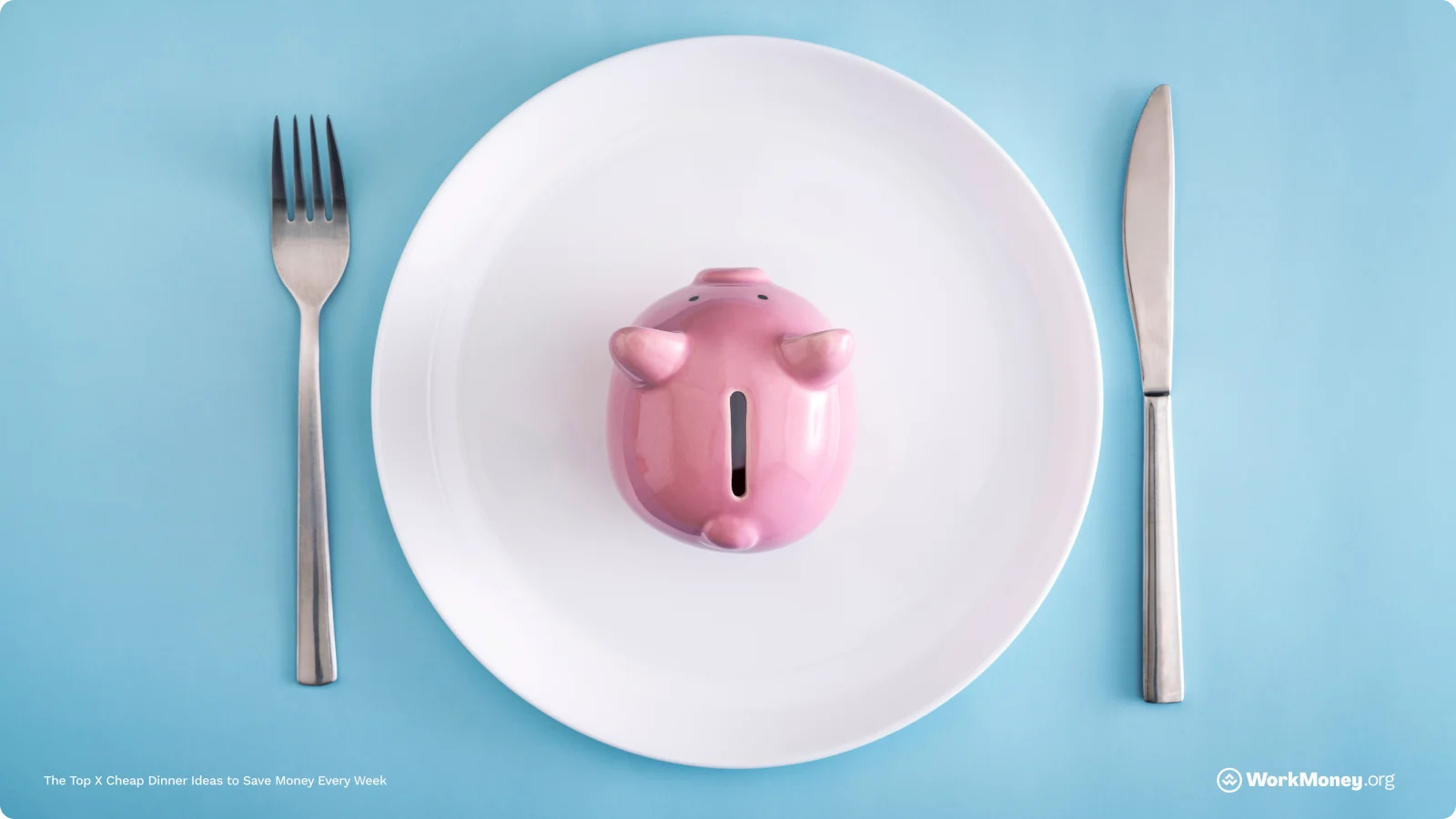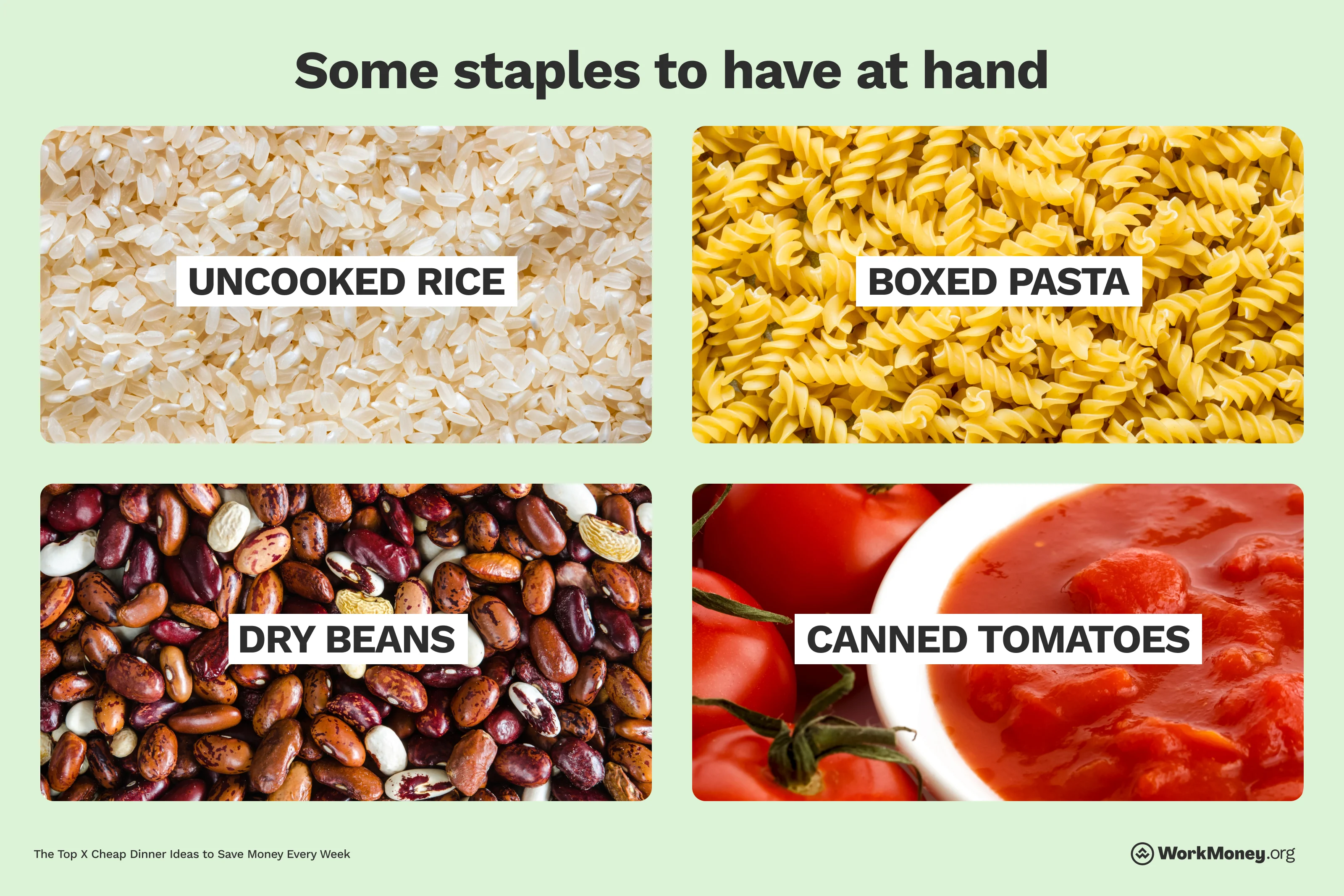The Top 5 Cheap Dinner Ideas to Save Money Every Week
Enjoy delicious meals while also saving your hard-earned money

Groceries continue to eat up more of our collective budgets each year. A recent Wall Street Journal story detailed how we are spending more than 11% of our income on food. This may not sound like much, but that figure hasn’t been seen since 1991. Rising figures are hitting both food at home and dining out.
If you’re on a stringent budget, the first thing you can do is cut eating out completely. It can be expensive, and set you back on your financial journey. You can start cooking more affordable meals at home to save some real money.
The WorkMoney team is here to help readers enjoy delicious meals while also saving their hard-earned money.

Budget-Friendly Dinner Foundations
1. Make A List, and Stick To It
Walking into a grocery store can be a financial trap for some. With so many options, it’s easy to walk in and grab whatever looks good to you, leading you to spend more than your grocery budget allows.
To avoid this, be sure to have a set grocery list before walking into the store. Doing this keeps you on track and under budget.
2. Have Staples On Hand
Many budget-friendly dinner ideas have several staples included in many meals. To avoid ordering or picking up food which can be significantly more expensive, have these staples in your pantry ready to go for quick, cheap meals:
Rice – White, brown, or jasmine—great base for stir-fries, bowls, or soups.
Pasta – Cheap, filling, and cooks fast—endless meal options.
Canned beans – Black, kidney, chickpeas, or pinto; great for protein-packed meals.
Canned tomatoes – Diced, crushed, or paste—essential for sauces, soups, and stews.
Peanut butter – Protein-rich, long shelf life, and good for savory or sweet dishes.
Rolled oats – Breakfast staple, but also useful in baking or making homemade granola.
Chicken or vegetable broth (boxed or bouillon cubes) – Builds flavor fast in soups and grains.
Canned tuna or salmon – Budget-friendly protein that’s ready to go.
Lentils – Fast-cooking legume, great for soups, stews, and salads.
Flour – For baking, thickening sauces, or making quick breads or pancakes.
Sugar – Basic baking essential and sometimes needed in savory dishes too.
Cooking oil (vegetable, olive, or canola) – Can’t cook without it!
Onions – Long-lasting and a flavor base for almost every dish.
Garlic (fresh or jarred) – Adds depth to any savory recipe.
Basic spices – Start with salt, pepper, chili powder, cumin, Italian seasoning, and paprika.
By having these regularly on hand, you can be able to create meals quickly without going to the store or eating out.
3. Batch Cooking Is Time and Money-Efficient
Batch cooking cuts down on dishes, but the lure of it is the ability to eliminate food waste and save money on your per-meal costs. For example, making a large amount of chili or pasta doesn’t take more effort than a single serving, and you can save on using your appliances more.
So when you’re thinking about future meals, consider looking into one where you can make alot of it and store it for future meals.
The Top 5 Cheap Dinner Ideas
Each of the recipes below is nutritious, can be made in batch quantities, and budget-friendly.
As you’re planning meals, look into Instacart and Upside to see if there are promotions and cash back to reduce your grocery costs even further.
Rice and Bean-Based Meals | |
Pasta Solutions | |
Egg-Centric Dinners | |
Soup and Stew Options | |
Ground Meat Stretchers |
Making Cheap Meals Nutritious
Focusing on making your dollars stretch doesn’t mean you have to give up the nutrients you want and need. You can still get protein and other essential dietary needs without having to spend big. Here’s a list of budget items to get the nutrients you need:
Category | Budget Grocery Items |
Vegetables | Carrots, cabbage, frozen mixed vegetables, onions, potatoes, canned tomatoes, spinach |
Protein | Eggs, dried or canned beans, peanut butter, canned tuna/salmon, tofu, lentils |
Whole Grains | Brown rice, whole grain pasta, oats, popcorn kernels, whole wheat bread, quinoa |
Additional Resources To Buy Groceries
If you’re doing everything you can to stretch your dollars and it still doesn’t seem to be enough, consider applying for either SNAP or WIC benefits. These federal assistance programs are put in place to help millions of Americans who need additional help for groceries each month.
SNAP benefits are distributed through an EBT card, and can be used at a variety of grocery stores and farmers markets to buy groceries. WIC benefits are focused on getting nutritious groceries to pregnant women, new mothers, and children under the age of five.
Both of these are largely based on financial circumstances, so if you’re in a pinch to afford groceries, it may be worth applying.
Final Thoughts
You don’t have to live on meals that aren’t nutritious or boring while being budget-conscious. You can eat well and continue your savings journey.
Like any habit or routine, it doesn’t happen overnight. To get started, try out a few of the meals listed above to see which one you prefer and work to put in your weekly rotation. As you discover more recipes, you can experiment with flavors you enjoy to create meals you love and help save money.
About the Author

Brett Holzhauer
Brett Holzhauer is a Certified Personal Finance Counselor (CPFC) who has reported for outlets like CNBC Select, Forbes Advisor, LendingTree, UpgradedPoints, MoneyGeek and more throughout his career. He is an alum of the Walter Cronkite School of Journalism at Arizona State. When he is not reporting, Brett is likely watching college football or traveling.

